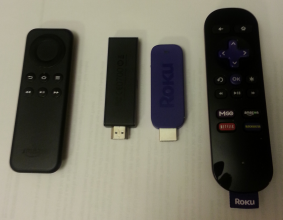Back in April of 2015 I wrote that picking a streaming media stick for road warrior use had just gotten easier. As of April of 2015, the only media stick that was well suited to hotel wifi (where you have to log in on a web page to connect to the Internet) was the Amazon Fire TV Stick. But now there is one more streaming media stick option for the road warrior.
The new media stick option for the road warrior is the Roku stick (at right).
is the Roku stick (at right).
The challenge, as mentioned above, is that most hotels will not let you connect to the Internet in the hotel except by logging in at a page on a web browser. And what I reported was that in April of 2015, Amazon had upgraded its Fire TV Stick firmware to include a rudimentary web browser. The road warrior who had just checked in to a hotel could use that web browser (visible on the screen of the hotel television, because of the Fire TV Stick) to log in to the hotel’s wifi. At the time, the Fire TV Stick was the only streaming media stick that could cope with such a login procedure.
But now, with little fanfare, Roku has upgraded the firmware on many of its streaming media devices to provide a way to log in at the hotel’s wifi. You can see a list of upgraded devices here.
Roku chose a very different way than Amazon to deal with the hotel login challenge. Amazon added a rudimentary web browser to its firmware. In contrast, Roku chose to use the web browser that is in your smart phone or laptop or tablet. To connect the Roku device to your hotel’s wifi, you start by trying to connect the device to the wifi. The connection will sort-of succeed in the sense that the device will have a connection to the wifi access point. But the device will be unable to get past the hotel’s default gateway to the Internet at large.
At this point, the Roku device will ask you if you are in a hotel or dorm, a question that is to be answered “yes”. The device will then splash a complicated message onto the screen of the hotel TV. The message will invite you to fire up your smart phone or tablet or notebook computer and to connect to a rather oddly named wifi network using a WPA encryption key. You will next be invited to open a web browser on your smart phone or tablet or notebook computer. Having opened the web browser, you will see the hotel’s login screen. At this point you will log in, by entering (say) your room number and last name.
What’s going on here? What’s going on is that the Roku device is simultaneously serving as a wifi client and a wifi server. It is a wifi client for purposes of trying to connect to the hotel wifi. And it is a wifi server for purposes of allowing you to connect to the device with your smart phone or tablet or notebook computer.
Eventually you will (hopefully) successfully enter information into your browser that will induce the hotel to grant Internet access to the Roku device. The Roku device will (hopefully) successfully reach some hosts external to the hotel’s default gateway. At that point the device will extinguish its temporary wifi server and the screen of the hotel TV will show a fully functioning Roku home page.
If as a road warrior you are already carrying a Fire TV Stick with you, you may want to stick with what you are familiar with. But if you are just now getting ready to start carrying a streaming media stick with you on your travels, keep in mind that you have two streaming media sticks to choose from. If you are already familiar and comfortable with the user interface for one of the two families of streaming devices, you may want to pick a device from that family for your road warrior viewing.
